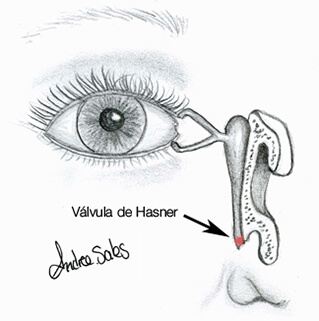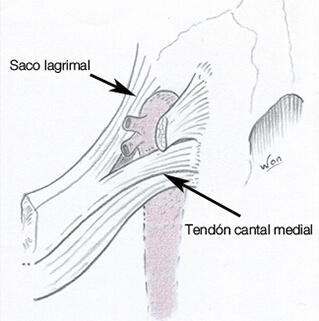The most common cause of tearing in children is congenital (from birth) obstruction of the tear duct. This occurs because a small valve at the junction of the tear duct with the nose (Hasner’s valve) is not naturally permeabilised during embryonic development. This is very common, in fact a high percentage of children are born with the valve not open, and it opens on its own during the first months of life.
Although it is usually a congenital obstruction of the tear duct, an initial assessment by the ophthalmologist is recommended to rule out other possible causes that are much less common. This initial check-up can be done at around one month of age.
No, it is normal for the obstruction to open on its own during the first year of life. During this time, what is recommended is to massage the lacrimal sac to try to get it to open sooner. It is important to massage it well in order for it to be effective. The lacrimal sac is located between the two branches of the medial canthal tendon, which can be felt as an induration on the inner canthus. The massage consists of pressing on the medial canthal tendon to increase the pressure inside the lacrimal sac and try to overcome this pressure on the obstructed membrane. Logically, on many occasions, when the sac is squeezed and the pressure is increased, part of the contents of the sac goes backwards and comes out through the lacrimal points, which is why you can sometimes see discharge of lacrimal fluid or pus through the lacrimal points when the massage is carried out properly. This does not indicate any problem, and the only thing to do is to wash the eye well with saline at the end of the massage.
It is generally necessary to wait until the child is one-year-old, as during this period it is very common for it to pass on its own without surgery, helped by massages. When it has not passed before the first year of life, surgery or catheterisation is indicated. Catheterisation is a very simple and non-aggressive procedure that consists of passing a very fine catheter through the tear duct and perforating the membrane that has not opened on its own. The surgery is practically painless, but given that they can move and the catheter may not pass through properly, it is always advisable to do it with a mask. Theoretically, it is a general anaesthetic, but the child is not intubated. The child is simply given an anaesthetic gas that puts him/her to sleep and is manually ventilated while the tube is passed. It is a very safe and very quick procedure. It is done on an outpatient basis, without the need for hospital admission and with an immediate recovery, allowing the child to lead a normal life when leaving the clinic.
Catheterisation is effective in a very high percentage of cases. Efficacy decreases progressively from about one and a half years of age onwards. When catheterisation is not effective, there are additional surgeries that are performed in stages to treat the obstruction, such as intubation of the lacrimal duct, dilation of the duct with a balloon catheter, or standard surgery in adults. It is exceptional to have to go there.



CONTACT US
IMO Grupo Miranza Madrid
C/ del Valle Pinares Llanos, 3, 28305 Madrid
910 783 783

